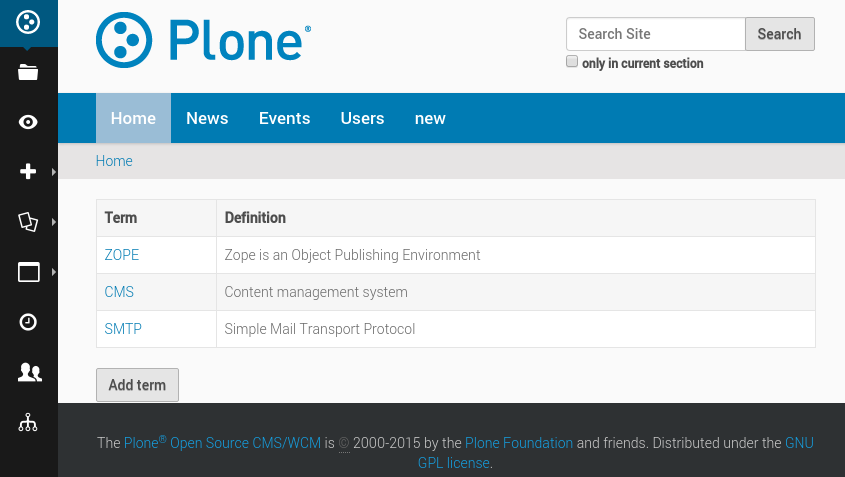Glossary use case¶
Objective¶
We want to provide a tool to manage a list of terms and their definitions:

Every time one of these terms appears on a page of our site, it will be wrapped into a <abbr> tag, the title of which will be the definition, so when we hover a term, we get a small popup indicating its definition:

Application structure¶
rapido/
glossary/
blocks/
all.html
all.py
all.yaml
term.html
term.py
term.yaml
glossary.js
rules.xml
Rules.xml¶
<after css:theme-children="body">
<script src="/tutorial/++theme++test/rapido/glossary/glossary.js"></script>
</after>
This rule inserts in all our pages a javascript file in charge of replacing
matching words with <abbr> tags.
The term block¶
This block is a form allowing to create/edit/delete a glossary term. It contains two field elements and three actions.
term.html<p><label>Term</label> {term}</p> <p><label>Definition</label> {definition}</p> {_save} {_delete} {close}
term.yamltarget: ajax elements: term: TEXT definition: TEXT close: type: ACTION label: Close _save: type: ACTION label: Save _delete: type: ACTION label: Delete
term.pydef close(context): return context.app.get_block('all').url def on_save(context): return context.app.get_block('all').url def on_delete(context): return context.app.get_block('all').url
If we click on any action in this block, we want to be redirected to the main
management page. We do that by returning the all block URL (when an action
returns a string, it is used as a redirection URL).
The all block¶
This block lists all the existing terms in a table.
When we click on a term, we open it in the term block in edit mode,
and a button allows opening a blank term block to create a new term.
all.html<table class="listing"><tr><th>Term</th><th>Definition</th></tr> {list} </table> {new_term}
all.yamltarget: ajax view: id: glossary with_theme: true elements: list: BASIC new_term: type: ACTION label: Add term
The
viewsetting allows to render theallblock as Plone view named@@glossary, so we can call http://localhost:8080/Plone/@@glossary to see it.all.pydef list(context): html = u"" for record in context.app.records(): html += """<tr><td><a href="%s/edit" target="ajax">%s</a></td><td>%s</td></tr>""" % ( record.url, record['term'], record['definition'], ) return html def new_term(context): return context.app.get_block('term').url
The list function builds a table row for each existing record,
displaying the term value and the definition value.
The link we put on the term targets the record URL (plus /edit to open it in edit mode)
and we have added target=”ajax” so the resulting page is not displayed as a full page,
it is just loaded into the current block in AJAX mode.
The Javascript¶
glossary.jsrequire(['jquery'], function($) { if($('.template-edit').length > 0) { return } $.getJSON('/tutorial/@@rapido/glossary/records', function(data) { var keys = []; var values = {}; for(var i=0; i<data.length; i++) { term = data[i].items.term; definition = data[i].items.definition; keys.push(term); values[term] = definition; } var re = RegExp("(\\W)(" + keys.join("|") + ")(\\W)", "g"); function replaceNodeText() { if (this.nodeType === 3) { var parent = $(this).parent(); var html = parent.html(); if(html) { var newvalue = html.replace(re, function(){ var term = arguments[2], before = arguments[1], after = arguments[3]; term = '<abbr title="'+values[term]+'">'+term+'</abbr>'; return before + term + after; }); parent.html(newvalue); } } else { $(this).contents().each(replaceNodeText); } } $("#content-core").contents().each(replaceNodeText); }); });
First thing we do is to check if we are in edit mode, and if we are, we stop, as we do not want to manipulate the HTML currently being edited in TinyMCE or in any input field.
Then we load the glossary terms with the following JSON call:
/tutorial/@@rapido/glossary/records
Using the term values we have loaded, we build a regular expression able to match those terms in any text.
Then we iterate on the page main content (#content-core) elements, and every
time we find a text node, we use our regular expression to replace the matching
words with an <abbr> tag where the title attribute is the associated
definition.